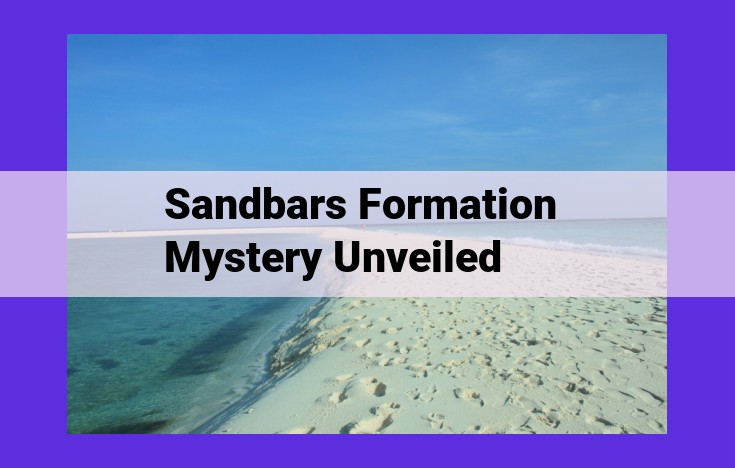Unveiling Sandbar Formation: The Interplay Of Sediment Deposition, Erosion, And Channel Morphology
Sandbar formation, once a mystery, is now unveiled through the interplay of sediment deposition, riverbank erosion, and channel morphology. Sediment deposition, influenced by hydrodynamic sorting and overbank flows, forms the building blocks of sandbars. Riverbank erosion, driven by lateral scour, creates favorable conditions for sandbar development. Sandbars, including point bars, are shaped by channel morphology and flow patterns. Understanding these dynamics is crucial for managing and protecting rivers, recognizing the interconnectedness of sediment deposition, erosion, and channel form.
Sediment Deposition and Flow Dynamics
- Explain the process of sediment deposition and its impact on sandbar formation.
- Discuss the role of hydrodynamic sorting and point bars in sedimentation.
- Describe how overbank flows contribute to sandbar accumulation.
Sediment Deposition and Flow Dynamics: Unraveling the Secrets
In the realm of riverine ecosystems, the formation of sandbars emerges as a captivating phenomenon, shaping the intricate dance of water and sediment. The process begins with sediment deposition, a crucial mechanism that paves the way for sandbar development. As water flows through a river, it carries sediment particles of varying sizes. Heavier particles, such as pebbles and gravel, settle to the riverbed, while lighter particles like sand are transported downstream.
Hydrodynamic sorting plays a pivotal role in this deposition process. As the velocity of water changes, it exerts different forces on particles of varying sizes. This sorting process results in the segregation of sediment, with finer particles being deposited in areas of lower velocity.
Point bars emerge as prominent features along riverbanks. These crescent-shaped deposits of sediment form on the inside bends of meandering rivers. Here, the water slows down and the centrifugal force pushes sediment towards the bank. The accumulation of these sediment deposits creates favorable conditions for the growth of sandbars.
Additionally, overbank flows contribute significantly to sandbar formation. During periods of high flow, water spills over the riverbanks and floods the adjacent floodplain. As the water spreads across the floodplain, its velocity decreases, causing the deposition of sediment. Over time, these sediment deposits build up, forming sandbars that may eventually become permanent fixtures in the river channel.
Riverbank Erosion and Channel Morphology: The Hidden Forces Shaping Sandbar Formation
The dynamic nature of river systems is a captivating dance of water, sediment, and landforms. Riverbanks, the boundaries between land and river, play a crucial role in sculpting sandbars, ephemeral islands of sand that offer havens for wildlife and shape the flow of water. Let’s delve into the intriguing connection between riverbank erosion and channel morphology, and their profound impact on sandbar formation.
Riverbank Erosion: The Silent Sculptor
Riverbanks are constantly under assault from the relentless force of flowing water. This erosive power is particularly pronounced on outer banks, the riverbanks on the outside of bends in the river. As water rushes around the bend, centrifugal force pushes it towards the outer bank, creating lateral scour. This concentrated flow erodes the bank, creating vertical overhangs and undercutting at the base.
Channel Morphology: Dictating the Flow
The shape of a river channel exerts a profound influence on the flow patterns and sediment deposition within it. Meandering rivers, with their sinuous curves, promote the formation of sandbars due to a unique interplay of hydrodynamic forces. On the inside of bends, where the flow is slower, sediment settles out, creating point bars. In contrast, on the outside of bends, the faster-flowing water erodes the bank and transports sediment downstream.
The interplay of riverbank erosion and channel morphology creates a dynamic environment where sandbars are born, evolve, and eventually disappear. Point bars act as nucleation sites for sandbar formation, providing a stable base for sediment deposition. As sediment accumulates, the sandbar grows, extending into the river channel and influencing the flow patterns. This dynamic feedback loop continues until the sandbar reaches a point of equilibrium, where the erosive forces of the river balance the depositional forces.
The formation and evolution of sandbars are a mesmerizing spectacle, orchestrated by the intricate interplay of riverbank erosion and channel morphology. Lateral scour, point bars, and meanders combine to create a dynamic landscape that is constantly reshaped by the relentless flow of water. Understanding these processes is essential for managing and protecting riverine environments, ensuring the continued vitality of these aquatic ecosystems and the communities that depend on them.
Sandbars: Nature’s Riverine Sculptures
Nestled within the enigmatic embrace of flowing water, sandbars emerge as ephemeral islands of sand, beckoning us to explore the captivating interplay of river dynamics. As we unravel their hidden stories, let’s dive into the secrets of sandbar formation.
The Genesis of Sandbars
Rivers, as they meander through their landscapes, carry a ceaseless stream of sediment. As water velocity slows in certain areas, such as inside river bends or where obstacles obstruct the flow, sediment deposition takes center stage. Over time, these sediment accumulations grow into sandbars, shaping the river’s morphology and creating unique aquatic habitats.
Point Bars: Sandbar Architects
Point bars, which form on the inside of river bends, play a pivotal role in sandbar creation. As water flows around the bend, it erodes the outer bank, releasing sediment into the current. This sediment is then transported downstream and deposited along the point bar, forming a gently sloping accumulation of sand and gravel.
